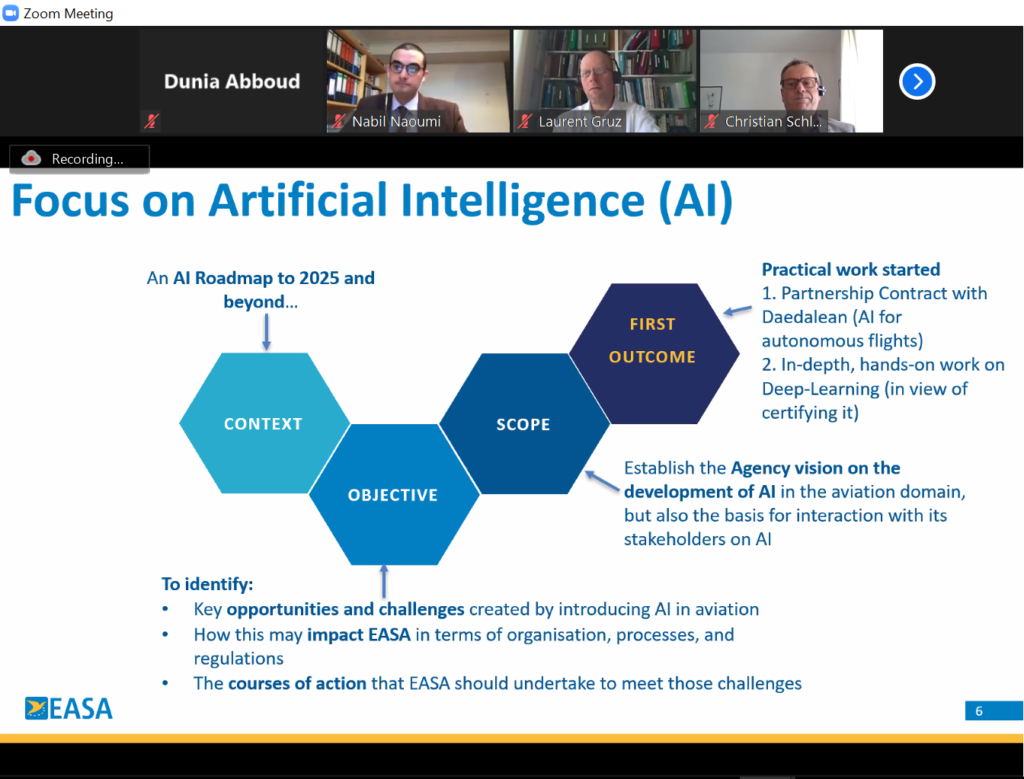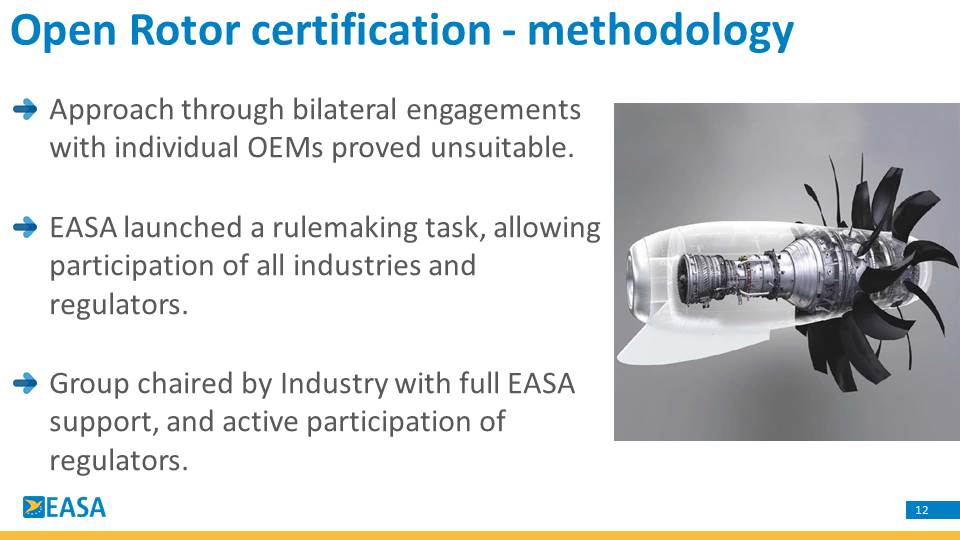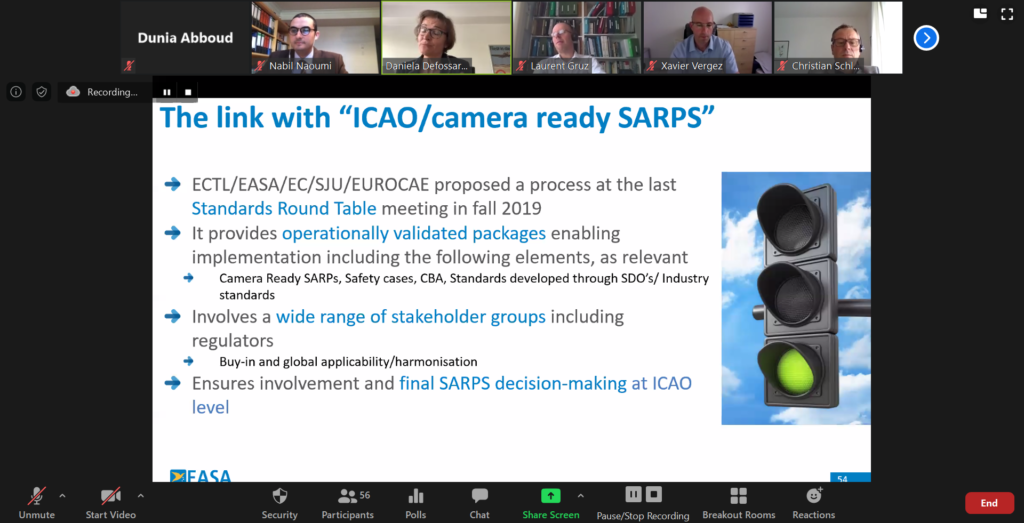While innovation has always been part of aviation’s DNA, the pace it is moving at today has gained momentum. This acceleration has had major effects on the aviation ecosystem, with the first challenge being to understand how regulators can best prepare for, respond to and embrace it. Indeed, dealing with disruptive innovation while carrying out business as usual, exposes national and regional regulators to the risk of falling behind and not being able to improve their working methodology. Another challenge is to meet the existing high, multifaceted expectations of different stakeholders.
In the most recent session of ANC Talks that took place on Wednesday, May 20th, the European Union Aviation Safety Agency (EASA), supported by EUROCAE, brought these issues to the forefront. Discussions centred around the challenges innovation brings to aviation, with a focus on Urban Air Mobility (UAM), EASA’s experience with innovation, EASA’s artificial intelligence (AI) roadmap and the Runway Overrun and Alerting System. The conclusions highlighted existing and future coordination with ICAO, considering innovation is perpetual in aviation. Presenters included Jean Marc Cluzeau, Principal advisor to EASA executive director; Maria Algar Ruiz, Programme Manager Drones; Xavier Vergez, EASA senior policy officer, Daniela Defossar, EASA ICAO senior coordinator, Laurent Gruz, EASA representative to ICAO and Canada and Christian Schleifer-Heingaertner, EUROCAE Secretary General.

Though the general public expects electric and hybrid propulsion to contribute to cleaner skies, that UAM will relieve congestion in city centres, and artificial intelligence will increase safety levels, private investors see an opportunity to develop new businesses. The challenge on the regulatory side, where there is a stable regulatory environment that is quite prescriptive and not fit for dealing with all possible innovations, is that there is a need for creating a more flexible framework while keeping the level of safety as high as it is today, if not higher.

EASA discussed the ways they have been integrating innovation in their work and how they intend to continue to do so in the future. To facilitate this, the European Union Agency identified six pillars:
- The first pillar is to organize innovation as part of their business. This is reached with the creation of an innovation cell, whose role finds its importance in the coordination of all activities dealing with disruptive innovations. This cell is also responsible for seeking solutions by identifying specific actions that should be taken, both internally and externally.
- The second pillar is to be technology agnostic and move towards more performance-based regulation.
- The third adapts the Agency’s methodologies, with the typical example of AI given. EASA has been working on new methodologies to certify new developments.
- The fourth pillar involves engagement with new entrants. Indeed, the landscape of stakeholders of the Agency has been changed radically with a fairly high number of new players developing new products, new business models and services, and requests to collaborate with EASA. It is important for the Agency to have the capacity to take them on board for two main reasons: to help such stakeholders develop their aviation safety culture, considering some do not have a mature aviation safety culture which often leads them to minimize the aviation safety risk; the second aspect is that EASA wants to learn from these organizations since many of them are at the edge of innovation and from which the Agency can benefit.
- The fifth pillar is to learn from the industry in order to avoid any knowledge gap between regulators and the industry.
- The sixth pillar is to integrate innovation as a corporate value. This has been reached through the creation of an internal network comprising 20% of the Agency staff with the purpose of sharing innovation knowledge.
Innovation is moving so fast that regulators like EASA must anticipate the developments of competencies of their experts or they will expose themselves to the risk that their experts will not have the necessary competencies to conduct a proper assessment of new technologies. To reach the required level of knowledge of new innovations as early as possible, the Agency has been working with innovative industry players by setting partnerships ahead of the development of new products or certifications.

One example of this is EASA’s approach on AI where their objective is to develop a vision and a programme aimed at accompanying the Agency through the development of AI. Published in February 2020, the Roadmap identified the opportunities and challenges created by regulating AI in aviation; how these might impact EASA in terms of the organization; and the processes and course of action that EASA should undertake to meet the challenges. The vision is to create a consistent and risk-based AI trustworthiness framework in view of approving safety-critical applications with the intent to prepare the agency to certify safety-critical use of AI in any of the core domains of the agency – aircraft, training methods, ATM solutions, etc.
This AI roadmap focuses on the most recent developments on AI being machine-learning and deep-learning. The timeframe of the roadmap is aligned with the industry – they will need to have the first approval of AI solutions by 2025 for large aircraft and already received in 2019 the first applications for first type certificates using machine learning AI applications. The timeline is designed to fit with milestones and contains three phases: the first phase is exploratory where the focus is on industry partnership and the development of first draft guidance usable for three levels of AI (human assistance/augmentation, human controls the machine but machine taking the lead, full autonomy); the second phase will start the certification of machine learning applications, once that is learned then guidance for machine-learning certification will be finalized; and the third phase will push barriers.
One very important consideration for EASA involves their decision to follow a human-centric approach to AI. Safety elements cannot be taken in isolation; rather there are significant challenges with the development of AI which are of an ethical nature. The European Union Commission established a high-level group that published in April 2019, a set of guidelines on AI and the concept of trustworthiness.
These guidelines include seven elements of trustworthiness, with safety as only one of the blocks. If safety was the exclusive focus, the whole picture might be missed with the more ethical dimension that is reflected in the trustworthiness concept. Risk mitigation is one of the main building blocks of the Agency’s approach to trustworthiness, and as such, they expect that risk mitigation methods are built to be able to deal with unexpected behaviours of AI.
EASA is aware that manufacturers are working on the aircraft of the future, with the ultimate goal being Single Pilot Operations (SPO). For this reason, EASA established an internal task force to work on different scenarios. Different technologies will be used for single-pilot operations, with some focus on ground assistance to compensate for the loss of one pilot, others on the advanced cockpit with support from artificial intelligence. By identifying different existing technologies, EASA understands it is preparing for the introduction of SPO in 2030.
In terms of hybrid electric aviation, EASA began the practical work with the certification of small aircraft and announced during the ANC Talks that they issued their first type-certificate on this week. The challenge here is gradual and follows the industry timeline, which is to have on the market 10-seat commuter aircraft by 2025 and by 2035, a 40-seat regional aircraft. Currently, a high-level task force with high-level industry representatives has been established to deal with this aspect of innovation.
Regarding UAM, considering the forecasted growth and evolution of the domain, with a particular increase of the number of drones aimed at providing delivery services, EASA has engaged in a number of activities based on two building blocks, to allow urban air mobility operations from the safety point of view and other aircraft operations, including environmental aspects, privacy protection, security and others. A concept paper was developed to share what types of operations the Agency expects to see implemented by 2025, and what will be the constraints based on the current services and their maturity in terms of autonomy. Topics addressed in EASA’s proposal are initial airworthiness, continuing airworthiness, air operations, crew licensing/training, ATM/UTM-U-space and Vertiports/operating sites.
EASA also shared an example of open rotors. Though the advantage of open rotors is that they are intended to lower fuel burn levels, they also present concerns. When there are issues, there can be a number of trade-offs: what you’re not doing at the engine level, you will need to do at the structure of the aircraft and vice versa; safety versus efficiency; safety versus environment; and noise versus emissions. Twenty years ago, early in 2000, there was a strong request to have a certification requirement for open rotor engines and engine manufacturers were working hard on related projects.

Though in the first step they followed the usual certification approach, bilateral engagements with individual aircraft and engine manufacturers to define special conditions proved unsuitable because there were too many discussions in parallel and it became difficult to maintain consistency. The alternative was to launch a much wider approach to rulemaking that allowed for the participation of all industries and regulators, with the industry-leading the project and regulators monitoring it. With the industry taking a different path, projects did not materialize and final rules were not published and reference material will remain on record. The outcome of this process was, however, quite positive: it led to a better understanding of technologies and the regulatory background and a rule was published in early 2016. There were still a few minority positions, but nothing that would have been resolved if a concrete project was started.
EASA also gave an example of the successful process to get to the Runway Overrun Awareness and Alerting System. Runway excursions are identified as one of the main causes of large aeroplane accidents in commercial air transport. Thus, taking into account the need for new onboard technologies to reduce the rate of runway excursions, a number of aeroplane and avionics manufacturers proactively started to design new onboard systems to address this issue.

Based on these emerging solutions, a rulemaking project on the topic was created to mandate and on-board the installation of such systems. In 2013 the European Working Group for Runway Safety published the European Action Plan for the Prevention of Runway Excursions (EAPPRE) recommending, among other things, that manufacturers make widely available, real-time monitoring and alerting systems. The Agency then published the first notice of the proposed amendment, but because of existing differences in the design of solutions, it was required to set technical standards that provide Minimum Operational Performance Standard (MOPS) before mandating them. Cooperation with a standard developing body was seen as essential to ensuring worldwide harmonization and to easing the certification processes. In 2015, EUROCAE accepted the task and published the Terms of Reference for a working group to develop MOPS to ensure appropriate awareness and alert the crew when the landing distance is estimated to be insufficient for a safe landing. This group had global participation. The industry standard includes a number of performance-centric requirements and should give the pilot the necessary indication and warnings at the right time to make the right decisions.
Two years later (in 2017), the full set of the development on the standard was completed and the ED-250 was published. It took less than two years to take an idea – to standard publication – to the time of developing a product. This is referred to as the industrialization phase, during which research and development are carried out to support the regulatory frame of the certification process and ensure a standard is available that the regulator can refer to. After this successful standardization, EASA proposed NPA 2018-12, which proposes to require the installation of ROAAS on new large aeroplane designs (CS-25), and on certain new large aeroplanes operated in commercial air transportation (CAT), and manufactured after a predetermined date.
In summary, the objectives are based on non-prescriptive requirements that we provide in rules. What is required are energy-based calculations of the predicted landing stopping point that have real-time alerts to flight crew both inflight and on the ground, when the system identifies that the aircraft is at risk of not being able to stop within the available distance. Certification is supported by the EUROCAE ED-250 MOPS for a Runway Overrun Awareness and Alerting System which by reference in the Acceptable Means of Compliance (AMC) corresponding to the rules.
Again, EASA considers industry partnerships are key in preparing for the future. To facilitate such partnerships, it developed two tools. The first is the Memorandums of cooperation on innovation that are intended to provide a general framework which enables cooperation in the early stages of innovation: workshops, research cooperation, universities networking, etc. Innovation partnership contracts are the second, they allow for the Agency to work together with industry partners on specific projects, to bring knowledge to the industry partners on the certification process, safety assessment methods, and on the other hand learning from an industry partner.

EASA concluded the talk by sharing a number of key takeaways. Together with a number of organizations – EUROCAE and EUROCONTROL, the European Commission and Cesar Joint Undertaking – EASA issued a proposal at the last standards roundtable meeting for a process, recognizing that many of the innovations first appear on a regional/local level and that they are complex in nature and include exploratory phases. EASA developed a concept of operations and guidance to enable the implementation of the following elements, as relevant: Camera Ready SARPs, Safety cases, CBTA, Standards developed through SDO’s/ Industry standards. These could be presented to ICAO as ideas to see how they can be brought further through the SARPs decision-making process, enabling ICAO to build on the experience of regulators such as EASA around the world.
Innovation in aviation is constant and multiform, it never stops, and the drivers are a combination of technology, market demand, safety and processes, making it complex. Most innovations benefit from an integrated approach, not only looking at one domain but rather at the product, the operational environment, the human factor elements, and of course, environmental aspects. Not all innovations succeed, but regulators and industry can both benefit and learn from their experiences. Failures also have the capacity to bring innovation further by prioritizing and focusing discourses on what appears to be sustainable for the future.
After the ANC Talk, Nabil Naoumi, the President of the ANC and spoke with the participants from EASA and EUROCAE to share further insight on this topic. Responses to his questions are shared in the video below.
About the authors
Dunia Abboud is Associate Analysis Officer in the Air Navigation Bureau at ICAO. Her work focuses on the advancement of data-driven decision making around the world, and she is now increasingly involved in innovation initiatives at ICAO.
Nabil Naoumi was elected President of the ICAO Air Navigation Commission for the year 2020 after serving on the ANC and as the Alternate Representative of the Federal Republic of Germany on the Council of ICAO since May 2016. Prior to that, he worked in several departments of the German Federal Aviation Office where his many tasks included the approval and oversight of production and maintenance organizations.

